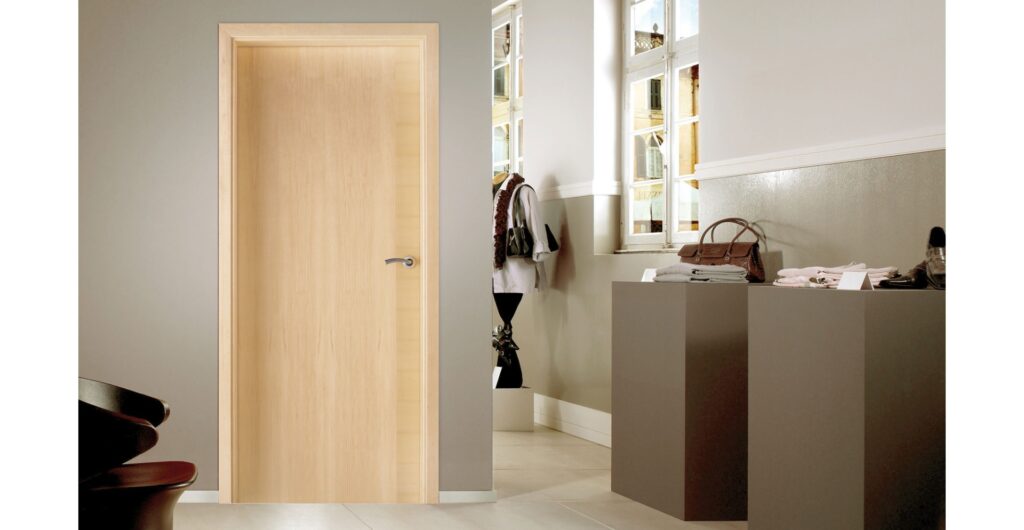When it comes to creating a warm and inviting atmosphere in our homes, few elements play a more significant role than interior doors. They not only provide privacy and separate our living spaces but also contribute to the overall aesthetic appeal of our interiors. One key decision to make when selecting interior doors is the type of wood used. The right choice of wood can enhance the beauty of your home while offering durability that stands the test of time. In this blog post, we’ll explore the best wood for interior doors, highlighting their unique characteristics, benefits, and how they can transform your living spaces into stylish havens of tranquility. So keep reading to learn more!
Importance of Choosing the Best Wood for Interior Doors
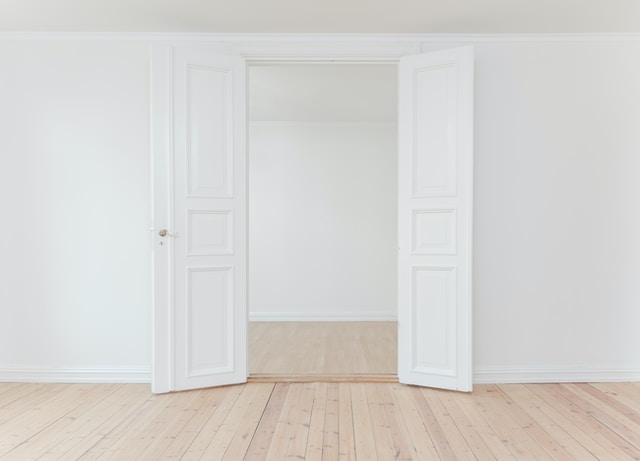
Choosing the best wood for interior doors requires a strict approach, and here’s why it matters. First off, durability is key. Interior doors go through a lot of wear and tear, so selecting a strong and sturdy wood ensures they won’t warp or crack easily.
But that’s not all. The appearance of your doors is important too! Different wood species offer unique grain patterns, colors, and textures, adding charm to your space. By being picky with your choice, you can find a wood that matches your style and complements your room’s overall design.
Other Things to Consider When Choosing the Best Wood for Interior Doors
When choosing the best wood for interior doors, there are several unique factors to consider. Here are some key considerations to keep in mind:

🟩 Aesthetics
Just as each person has their own unique style and personality, so too should your interior doors reflect your individual taste. The world of wood offers a stunning array of options, each with its own distinct grain patterns, color variations, and textures. It’s like a palette of possibilities waiting for you to unleash your creativity! Consider the existing design elements in your space, such as your flooring, furniture, and trim. Look for a wood species that harmonizes with these elements, creating a cohesive and visually pleasing environment that showcases your personal style.
🟩 Stability
Wood, like us humans, can be sensitive to changes in its environment. Swings in humidity and temperature can cause wood to expand or contract, potentially leading to warped or cracked doors. It’s like wood’s version of trying to fit into your favorite pair of jeans after a big holiday feast – not the best feeling! To avoid this, choose a wood species that is known for its dimensional stability. Engineered woods like medium-density fiberboard (MDF) or solid wood with engineered cores are excellent options as they tend to be more resistant to changes in their surroundings.
🟩 Maintenance
Let’s face it, life can get busy, and the last thing you want is to spend all your time maintaining your interior doors. So, it’s important to consider the level of care you’re willing to invest. Some woods require more attention than others, much like high-maintenance friends who constantly crave your time and energy. If you prefer a low-maintenance relationship, go for hardwoods that naturally resist wear and tear, requiring minimal upkeep. However, if you’re up for the challenge of regular maintenance, softer woods can still be a viable option, provided you’re willing to invest time in sealing and refinishing them to protect against moisture and damage.
🟩 Sound insulation
Peace and tranquility are essential in creating a comfortable living space. If you’re looking to keep unwanted noise at bay, consider the sound insulation properties of different wood species. Dense hardwoods, such as oak or cherry, act like natural sound barriers, offering better soundproofing compared to softer woods. It’s like having a built-in bouncer for your door, keeping the noise outside where it belongs.
🟩 Environmental impact
In a world where sustainability is becoming increasingly important, making eco-conscious choices is a win for both you and the planet. When selecting wood for your interior doors, consider the environmental impact of the wood species you’re considering. Look for wood that is certified by organizations like the Forest Stewardship Council (FSC), ensuring responsible forestry practices. By choosing sustainably sourced wood, you’re not only contributing to the preservation of our forests but also adding a touch of environmental stewardship to your home.
🟩 Budget
We all have financial considerations to keep in mind when embarking on home improvement projects. Different wood species come with varying price tags, much like the diverse range of items you’ll find on a shopping spree. Exotic or rare woods often command a higher price, while common hardwoods are generally more budget-friendly. It’s all about finding the sweet spot that aligns with your financial resources and balances it with the desired qualities and aesthetics you want in your interior doors.
Top 10 Best Wood for Interior Doors
➊ Mahogany

When it comes to selecting interior doors for upscale homes, Mahogany stands out as a popular and revered choice. Its reputation precedes it, thanks to its remarkable qualities that make it a go-to option for those seeking elegance and sophistication.
One of the most striking features of Mahogany is its rich, deep color. The natural hue of this wood species ranges from reddish-brown to dark brown, exuding a warm and luxurious ambiance within any space it adorns. The distinct coloration of Mahogany adds depth and character, instantly drawing attention and creating a captivating focal point.
But it’s not just about the color; Mahogany boasts alluring grain patterns that enhance its overall appeal. These intricate patterns, often displaying variations in texture and direction, create a visually captivating display on the door’s surface. The interplay of light and shadow on the grain further accentuates the door’s beauty, making it a captivating feature within any interior design scheme.
➋ Oak
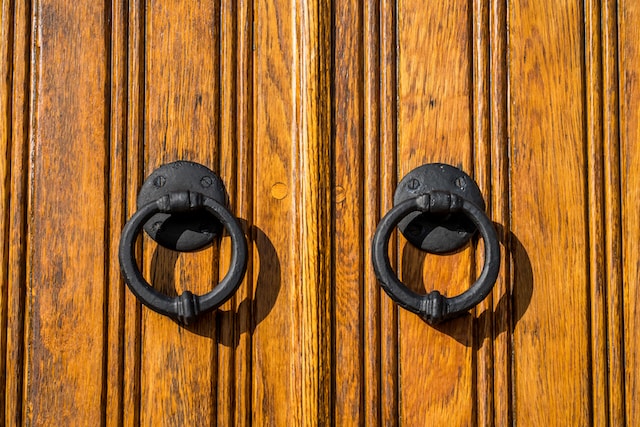
For centuries, Oak has stood the test of time as a remarkably strong and durable wood, finding its place in the creation of furniture and doors. This versatile timber has gained widespread popularity due to its outstanding qualities, making it a cherished material in the world of craftsmanship.
When it comes to oak, there are different varieties to choose from, each with its own distinct characteristics. Red oak and white oak are two prominent types known for their exceptional strength and beauty. Red oak tends to exhibit a warm and reddish hue, while white oak boasts a slightly lighter and more golden tone. Beyond color, what truly sets these varieties apart are their unique grain patterns.
The grain patterns of oak are like nature’s fingerprints on wood. They are the intricate lines and swirls that gracefully traverse the surface, showcasing the tree’s growth rings and adding a touch of natural artistry. Red oak typically displays a pronounced and striking grain pattern, capturing attention with its bold and eye-catching appeal. On the other hand, white oak tends to have a more subtle and elegant grain, offering a sense of refined sophistication.
➌ Maple
Maple, renowned for its exceptional strength and durability, stands tall as a hardwood option that can withstand the test of time. This resilient timber is highly regarded for its ability to resist wear and tear, making it a reliable choice for a wide range of applications.
One of the standout features of maple is its smooth and consistent grain. The grain pattern of this wood is characterized by its uniformity, resulting in a sleek and refined appearance. The absence of pronounced knots or irregularities gives maple doors a clean and minimalist aesthetic, making them a popular choice for modern interior designs.
The versatility of maple doors extends beyond their natural beauty. Maple is receptive to staining, allowing for a myriad of finishes and colors to be achieved. Whether you desire a light, natural look that highlights the wood’s inherent warmth or a darker, more dramatic tone, maple can be customized to match your desired aesthetic. With a wide array of stains and finishes available, maple doors provide endless possibilities for personalization and can effortlessly complement any interior style.
➍ Cherry
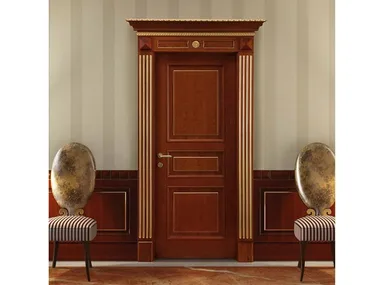
Cherry wood has earned a well-deserved reputation for being exceptionally prized, thanks to its remarkable attributes. One of its standout features is its captivating tones and exquisite grain patterns that instantly catch the eye. When cherry wood matures over time, it undergoes a mesmerizing transformation, gradually developing a deep and alluring reddish-brown hue. This aging process not only adds depth and character to the wood but also enhances the overall appeal of any door crafted from it.
The allure of cherry doors extends far beyond their color and patterns. These doors are cherished for their ability to evoke an atmosphere of timeless elegance and tradition. With their graceful presence, they effortlessly infuse a space with a sense of refinement and sophistication. Whether adorning a residential home or a commercial establishment, cherry doors never fail to make a striking impression.
➎ Walnut

Walnut, with its exceptional qualities, is a hardwood that commands attention and admiration. Its distinct dark brown color and the mesmerizing, lustrous grain make it truly one of a kind. When utilized in interior design, walnut possesses the remarkable ability to elevate spaces, imbuing them with a touch of luxury and sophistication.
The allure of walnut lies not only in its visual appeal but also in its inherent natural beauty. The deep, rich brown hue exudes warmth and elegance, creating a welcoming and inviting atmosphere. The grain patterns, with their intricate variations, catch the light and add depth, captivating the eye and creating a sense of depth and texture.
It is no wonder that walnut doors are often chosen for high-end homes and upscale settings. The presence of walnut doors instantly elevates the aesthetic of a space, conveying a sense of refinement and discerning taste. Whether it is a grand entrance to a luxurious residence or a statement piece in a sophisticated commercial establishment, walnut doors make a lasting impression.
➏ Alder
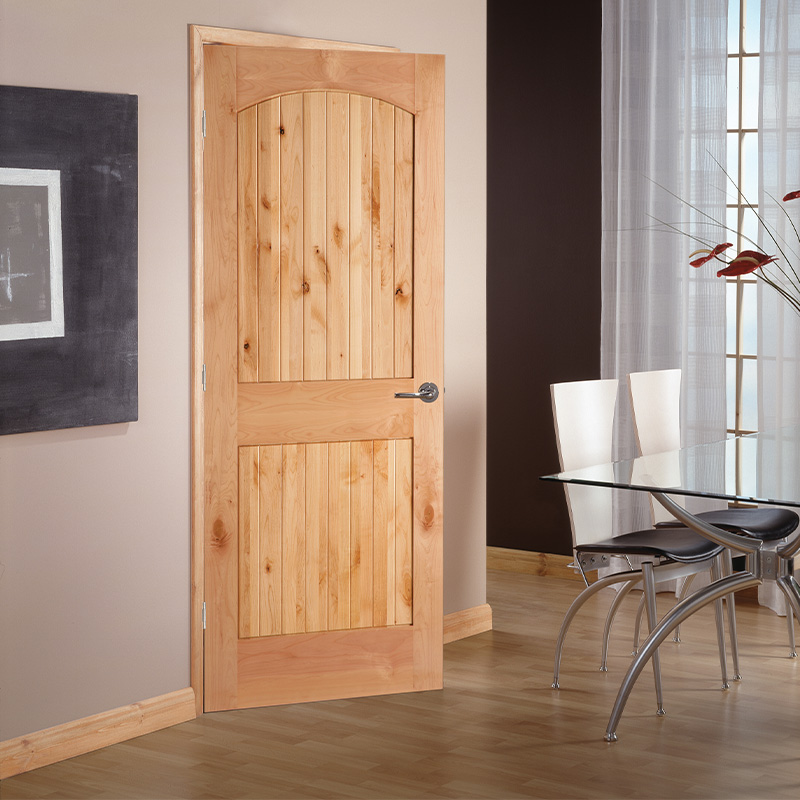
Alder possesses a unique set of characteristics that make it a versatile and sought-after material. With its straight grain and medium texture, alder showcases a smooth and even surface that’s pleasing to the touch.
One of the standout features of alder is its captivating range of light colors. From delicate pale yellow hues to captivating reddish-brown tones, alder presents a palette that spans across the warm and inviting spectrum. This inherent diversity allows for endless possibilities in interior design, enabling alder doors to seamlessly blend with various color schemes and aesthetics.
Affordability is another advantage that sets alder doors apart. They offer an accessible option for those seeking quality without straining their budget. Alder’s widespread availability and efficient manufacturing processes contribute to its reasonable price point, making it an appealing choice for homeowners and businesses alike.
➐ Pine
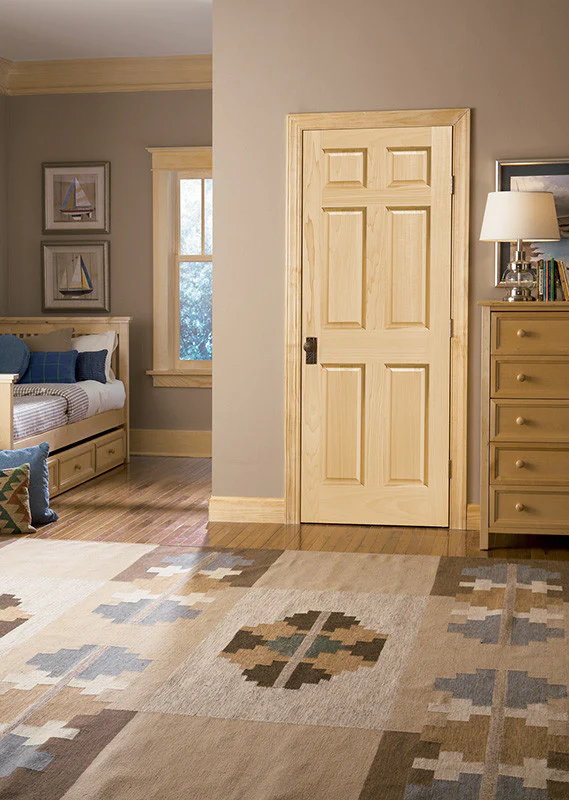
When it comes to interior doors, pine is a fantastic choice that offers both affordability and versatility. Pine is a type of softwood that has gained popularity in the world of interior design. One of the standout features of pine is its gentle and pleasing appearance, characterized by its pale and light color. This natural hue adds a touch of warmth and brightness to any room.
The great thing about pine doors is that they can easily adapt to various interior styles, making them a go-to option for homeowners with different design preferences. Whether you love the rustic charm of a countryside cottage or the sleekness of a contemporary urban dwelling, pine doors can seamlessly fit into any aesthetic.
But what makes pine doors truly remarkable is their ability to transform. With just a bit of creativity, you can completely change their look to match your desired atmosphere. If you prefer a more traditional vibe, staining the pine doors can bring out the natural wood grain and create a rich, classic appearance. On the other hand, painting them in vibrant colors can inject a modern and lively feel into your space. The possibilities are endless!
➑ Ash

Ash, a remarkable hardwood, possesses an array of desirable qualities that make it an exceptional choice for doors. One of its defining characteristics is its strength and durability. When you opt for ash doors, you can rest assured that you’re investing in a long-lasting and robust solution that can withstand the test of time.
Beyond its durability, ash boasts a captivating appearance. Its light-colored and creamy complexion adds a touch of elegance and sophistication to any space. Moreover, ash showcases a distinct grain pattern that sets it apart from other woods. This grain pattern, with its unique lines and textures, adds depth and visual interest to the doors, creating a stunning focal point in your interior design.
When it comes to customizing ash doors, you have the freedom to explore different finishes. Staining is a popular choice for enhancing the natural beauty of ash. By applying a stain, you can bring out the intricate details of the grain pattern, making it more pronounced and eye-catching. This approach not only accentuates the door’s natural aesthetics but also adds a touch of warmth and character to your living spaces.
➒ Fir
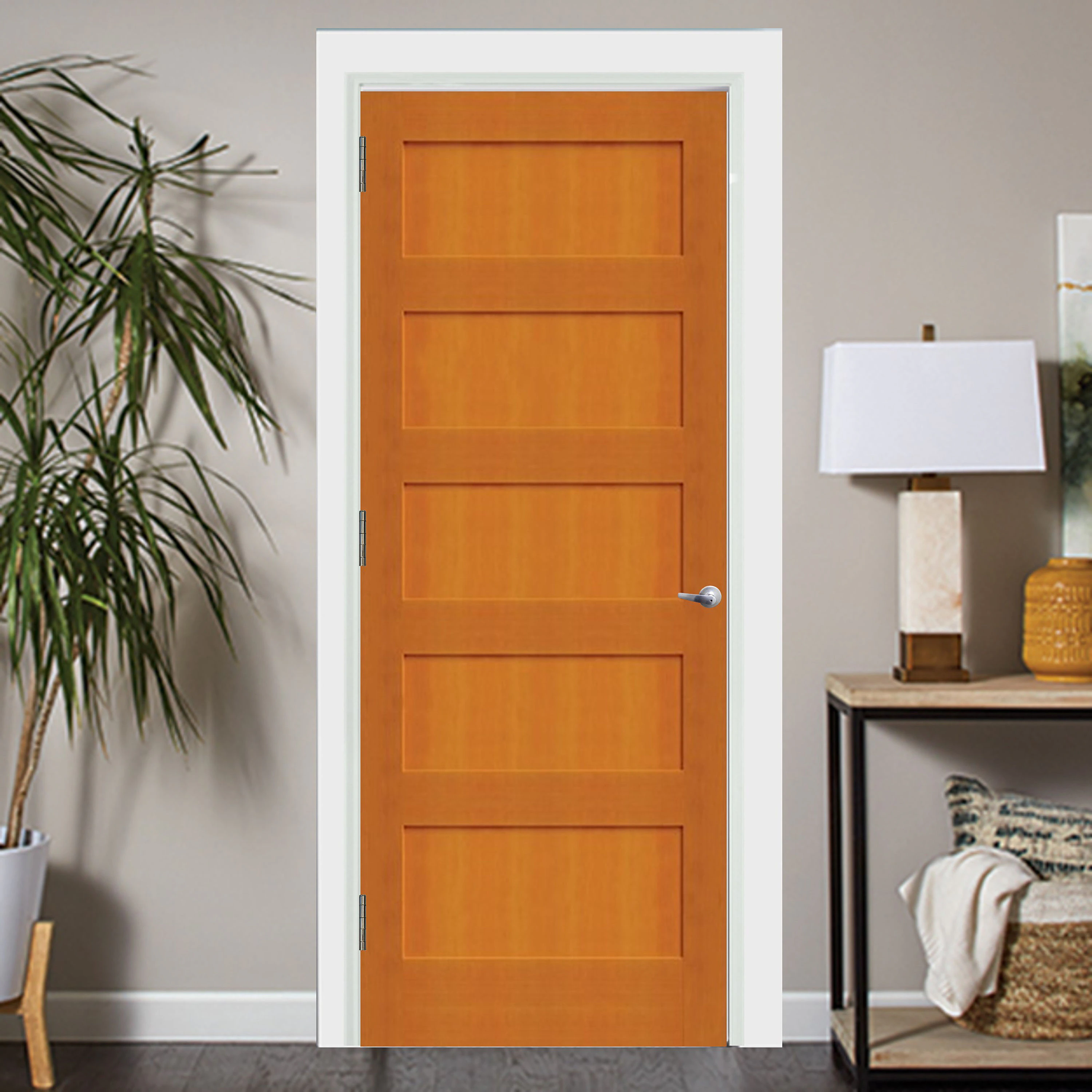
When it comes to interior doors, fir is a fantastic choice that brings a touch of rustic charm and cozy appeal to any home. As a softwood, it offers a unique character that is particularly well-suited for rustic or cottage-style designs.
One of the standout features of fir is its distinctive grain pattern. With a straight grain and occasional knots, fir doors have a natural beauty that sets them apart. These knots, rather than being flaws, add to the door’s charm and give it a rustic and authentic feel. They bring a sense of character and uniqueness, making each fir door truly one-of-a-kind.
Fir doors offer the flexibility to be customized according to your desired aesthetic. If you want to emphasize the natural beauty of the wood, staining is a great option. By applying a stain, you can showcase the wood’s warm and earthy tones, allowing the grain and knots to shine through. This brings out the door’s natural character, creating a warm and inviting atmosphere.
➓ Bamboo

When it comes to environmentally friendly options for interior doors, bamboo takes the spotlight as a sustainable superstar. Surprisingly, bamboo isn’t a traditional wood, it’s actually a fast-growing grass! This unique characteristic makes bamboo an incredibly eco-friendly choice. Unlike traditional wood, which takes years to grow and replenish, bamboo can be harvested and processed into durable panels within a relatively short span of time.
Bamboo doors offer a myriad of benefits, starting with their eco-conscious nature. By opting for bamboo, you’re making a positive impact on the environment. Bamboo’s rapid growth rate means that it can be sustainably harvested without causing significant deforestation. Choosing bamboo doors is a conscious step towards reducing your carbon footprint and embracing a more sustainable lifestyle.
But bamboo doors don’t just excel in their eco-friendliness; they also bring a unique and modern aesthetic to your home. With a wide range of natural color variations and distinct grain patterns, bamboo doors have an inherent beauty that sets them apart. The natural colors can range from light blonde to deep caramel, providing you with options to suit your personal style and complement your interior design.
How to Make Your Interior Doors Last Longer
Want to make your interior doors last longer? Follow these simple tips to keep them in great shape.
First, handle your doors with care. Avoid slamming them and teach others in your household to do the same. Gentle treatment prevents damage to hinges, frames, and the door itself. Additionally, regularly lubricate the hinges with a silicone-based or graphite lubricant to keep them smooth and silent. This simple step can significantly extend their lifespan.
Next, pay attention to maintenance and protection. Adjust latches and strikes to ensure a proper fit, preventing unnecessary stress on the door and hardware. Keep moisture at bay by avoiding placing doors in humid areas and promptly fixing any leaks or dampness. Clean your doors periodically with a mild detergent and soft cloth to remove dust and grime. Use rugs or mats near frequently used doors to shield them from scratches and scuffs. Finally, address any damage promptly, whether it’s cracks, loose hinges, or peeling paint. Taking care of these issues early prevents them from escalating into bigger problems.
By implementing these straightforward tips, you can significantly prolong the life of your interior doors and enjoy their functionality and appeal for years to come.
Final Words
In conclusion, when it comes to choosing the best wood for your interior doors, it’s crucial to consider both aesthetics and durability. Each wood type brings its own unique characteristics and charm to your living space, enhancing the overall ambiance and style. Whether you prefer the warm, inviting tones of oak or the luxurious allure of mahogany, investing in high-quality wood for your interior doors is a decision that will undoubtedly elevate your home’s interior design for years to come. So use this guide and your dream home awaits the first step towards perfection today!

